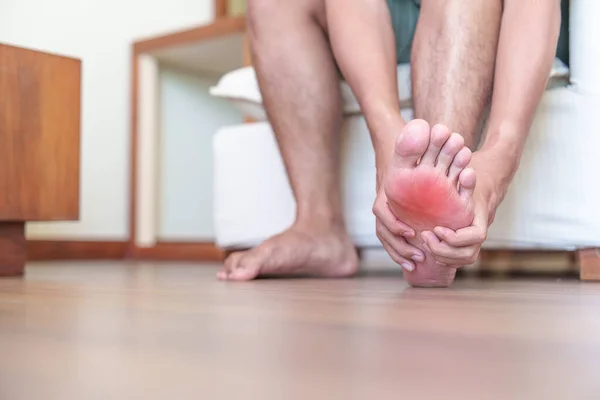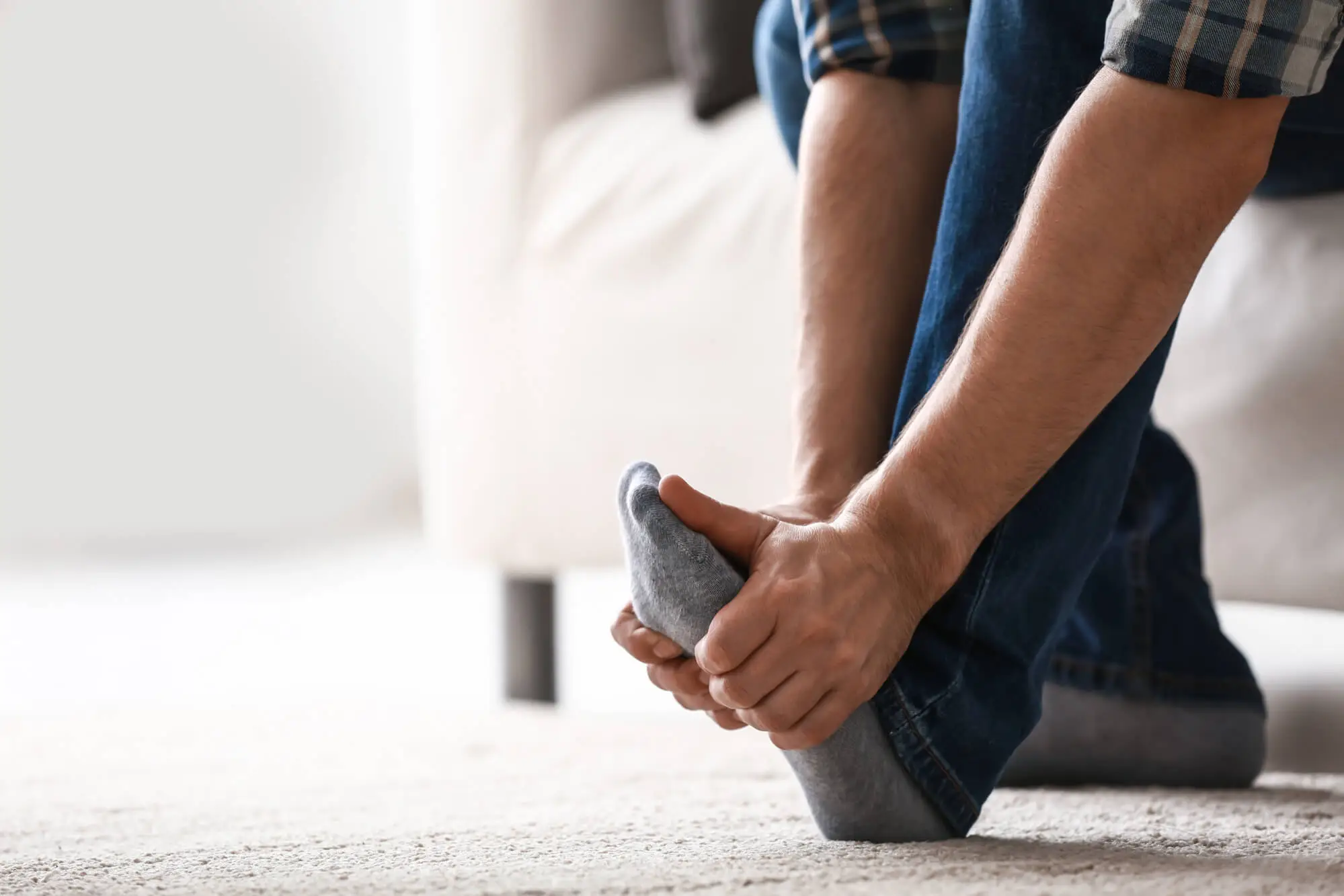Suffering from pain in your feet can not only be incredibly uncomfortable, but it can also be debilitating. This is especially true if the pain comes from the bottom of your foot. It’s challenging to manage this kind of pain if you constantly have to put weight on it to move around. If you’re experiencing such pain, you could have plantar fasciitis.
Getting a proper diagnosis and a better understanding of the condition is crucial to finding relief. With that in mind, the following is everything you need to know about plantar fasciitis, from the causes and symptoms to the best treatment options.
What Is Plantar Fasciitis?
Plantar fasciitis is a condition that causes intense pain and stiffness in the heel and bottom of your foot. It’s often caused by inflammation or irritation of the plantar fascia, which is a thick band of tissue connecting your heel bone to your toes. This inflammation or irritation is typically caused by injury or overuse of the foot.
Plantar fasciitis is a very common source of heel pain. It’s also a very common condition in general: it’s estimated that around 10 percent of people will experience plantar fasciitis at some point in their lives.
Causes Of Plantar Fasciitis
Any damage to the plantar fascia can result in inflammation, making it painful to walk on. It’s worth noting that it generally happens in one foot at a time but can also occur in both feet simultaneously. With that in mind, the following are some of the most common causes of plantar fasciitis:
Standing Or Walking For Long Periods Of Time
Plantar fasciitis is often caused by overuse. For example, when you stand for long periods of time, it can put extra strain on the plantar fascia. This strain can lead to inflammation and pain.
This can happen if you have a job requiring you to stand for extended periods, such as a waiter, nurse, or factory worker jobs. People who walk or run a lot can also be more prone to developing plantar fasciitis. For example, those who train for marathons, jog often, or regularly take long walks are more likely to develop plantar fasciitis.
Wearing Shoes With Inadequate Support
If your shoes don’t provide enough support for your feet and arches, it can cause strain on the plantar fascia. This is especially true if you wear shoes with thin or no soles. Wearing high heels and flip-flops is especially risky, as they can put a strain on the fascia and decrease stability in your feet. In addition, you’re more likely to develop plantar fasciitis if you are on your feet or walking for long periods of time while wearing shoes without proper support.
Having Flat Feet Or High Arches
People who have flat feet or high arches are more prone to developing plantar fasciitis. This is because there’s an increased risk of overstretching the plantar fascia when you have these kinds of feet. For example, if you have flat feet, you’re putting more pressure on the arch as you walk, which can result in inflammation and pain. If you have high arches, your feet may lack stability, making it harder to maintain balance and leading to damage to the fascia.
Exercising Without Proper Stretching Or Warm-Up
If you don’t stretch or warm up properly before exercising, it can cause strain on your plantar fascia. This is because the fascia needs to be flexible and prepared for the impact of exercise. Stretching out your calves and feet before you exercise will reduce the risk of developing plantar fasciitis because you’re warming up the tissue and making it less likely to be damaged.
Symptoms Of Plantar Fasciitis
Just because your foot hurts doesn’t necessarily mean you have plantar fasciitis. However, it is one of the most common causes of heel pain.
With that in mind, be sure to see a medical professional if you have any of these symptoms to determine if you have plantar fasciitis.
Common Symptoms of Plantar Fasciitis include:
Sharp Pain Under The Heel Or Arch Of The Foot
Arguably the most common symptom of plantar fasciitis is the sharp pain in the heel or arch of your foot. This pain is often worse when you first wake up in the morning and after standing or walking for a long time.
Pain That Worsens Over Time
Pain caused by plantar fasciitis can worsen over time, especially if it’s not treated. It may start as a dull ache, but if left untreated, it can develop into a sharp pain that makes it difficult to walk or stand. This pain worsens because the inflammation has had time to build up and cause more damage. Not to mention, if your plantar fascia is damaged and you continue to strain it, the pain will only worsen.
Difficulty In Walking
If pain from plantar fasciitis becomes severe, it can become difficult to walk or exercise. You may find that walking and running become painful, and that activities like jumping or hopping are too difficult. This can make it hard to do the simple tasks of everyday life, as well as engaging in physical activity.
Difficulty In Walking
Difficulty in walking is one of the most common types of disability in the US. According to reports, around 7% of Americans seriously struggle with walking or climbing stairs. This figure is much lower for people aged 18-34 (1%), but much higher for older...
Chronic Foot Pain
Dealing with chronic foot pain is debilitating enough as it is. After all, our feet are an essential part of our everyday lives, and any pain that interferes with their proper functioning can disrupt our daily activities. Many people attempt to treat foot...
Tendon Pain
When you are suffering tendon pain and inflammation, it not only causes discomfort but can directly impair normal mobility. The level of impact will vary based on the affected tendon but activities such as running, walking, lifting objects, or using fine...
Sharp Pain Under The Heel Or Arch Of The Foot
Foot pain, in general, can make it challenging to go about daily activities. Every time you take a step, your feet bear the weight of your entire body. So, when you experience sharp heel pain or pain in the arch of your foot, it can be debilitating, thereby...
Read More About Sharp Pain Under The Heel Or Arch Of The Foot
Treatment Options For Plantar Fasciitis
Plantar fasciitis can result in chronic pain that can affect your daily activities if left untreated. As such, it is vital to seek treatment as soon as possible. Fortunately, there are several options available for treating plantar fasciitis. The following are some of the more conventional treatment solutions that a medical professional might prescribe to treat plantar fasciitis:
Rest
Resting your feet is a key part of treating plantar fasciitis. This involves avoiding activities that put significant strain on the foot, such as running and jumping. Additionally, you should reduce the time spent on hard surfaces like concrete or asphalt. By resting your foot and keeping weight off it, you can give the plantar fascia time to heal.
Stretching Exercises
Stretching exercises can be a helpful way to reduce heel pain and inflammation associated with plantar fasciitis. These exercises target the calf and foot muscles, as well as the plantar fascia itself. Additionally, stretching can help improve flexibility in the foot, preventing the injury from worsening and reducing the chance of developing further injury.
Wearing Supportive Shoes
Wearing shoes that offer adequate support for the foot is an integral part of the treatment for plantar fasciitis. This means wearing shoes that provide arch support, cushioning, and good shock absorption. Additionally, wearing supportive shoes can help reduce the strain on the plantar fascia and the surrounding muscles, which can help reduce pain.
Steroid Injections
Steroid injections are a more aggressive form of treatment for plantar fasciitis. These injections contain a steroid medication injected directly into the area of pain to reduce inflammation and provide pain relief. While they can be effective, steroid injections should be used with caution since they can result in side effects such as damage to surrounding tissue and an increased risk of infection.
Surgery
If you’re suffering from severe pain and your doctor has exhausted all other treatments, surgery may be recommended as a last resort. There are two surgical procedures that are commonly done to treat plantar fasciitis. The first is gastrocnemius recession, which involves lengthening the calf muscles to help reduce pressure on the plantar fascia. The second is plantar fascial release, which involves making tiny incisions into the plantar fascia to relieve tension.
Although these surgical procedures can be effective, they are generally expensive and have their share of risks. Surgery of any sort comes with the risk of complications. Surgical complications can include infections, nerve damage, and scarring. Not to mention, there’s no guarantee that your plantar fasciitis pain will be eliminated entirely.
Neurofunctional Pain Management: The Safe And Effective Treatment For Plantar Fasciitis
Neurofunctional Pain Management is a combination of electroanalgesia and IV therapy. It’s one of the most effective methods for treating chronic pain, including plantar fasciitis pain. Electroanalgesia involves using high-pulse electrical currents to stimulate the nerves and send signals to the brain. These signals block or reduce painful sensations, providing relief from chronic pain, as well as stimulating the production of endorphins, which act as the body’s natural painkillers.
Electroanalgesia is an FDA-approved treatment solution that’s been around for decades. Unfortunately, it’s less popular than other treatment methods because it takes multiple sessions to see optimal results. Many medical professionals opt for a quicker fix, even if it’s less effective. However, unlike other treatment solutions, electroanalgesia is entirely safe and helps treat the actual condition, not just the symptoms.
We recommend two sessions of electroanalgesia a week for 6-12 weeks for optimal results. Additionally, as part of our Neurofunctional Pain Management approach to treating chronic pain, we pair our electroanalgesia therapy with specialized IV hydration therapy, which helps to reduce inflammation, and lifestyle counseling to help patients manage their pain and achieve long-term relief.
Electroanalgesia
Electroanalgesia is a pain management technique that uses high-pulse electrical current to ease pain, boost blood circulation, improve mobility, and induce...
IV Therapy
IV nutritional therapy, or intravenous therapy, involves administering vital nutrients directly to the bloodstream through an IV. This type of treatment bypasses the digestive system, allowing for maximum absorption and utilization of nutrients by the...
Lifestyle Counseling
Lifestyle counseling is an approach to managing chronic pain that involves identifying, assessing, and modifying lifestyle factors contributing to an individual's pain. For example, lifestyle factors such as nutrition, physical activity, stress, sleep quality...
Get Breakthrough Solutions For Plantar Fasciitis Pain
At Neuragenex Neurofunctional Pain Management, we are pioneering a revolutionary approach to treating chronic pain. Our Neurofunctional Pain Management program combines cutting-edge electroanalgesia, IV therapy, and lifestyle counseling to provide breakthrough solutions for plantar fasciitis pain.
As a part of our program, we also provide specialized hydration, nutritional deficiency replenishment, and patient education programs to help achieve long-term relief from plantar fasciitis and other chronic pain conditions.
Take steps to prevent and treat plantar fasciitis. Talk to us for expert advice and effective treatment.








